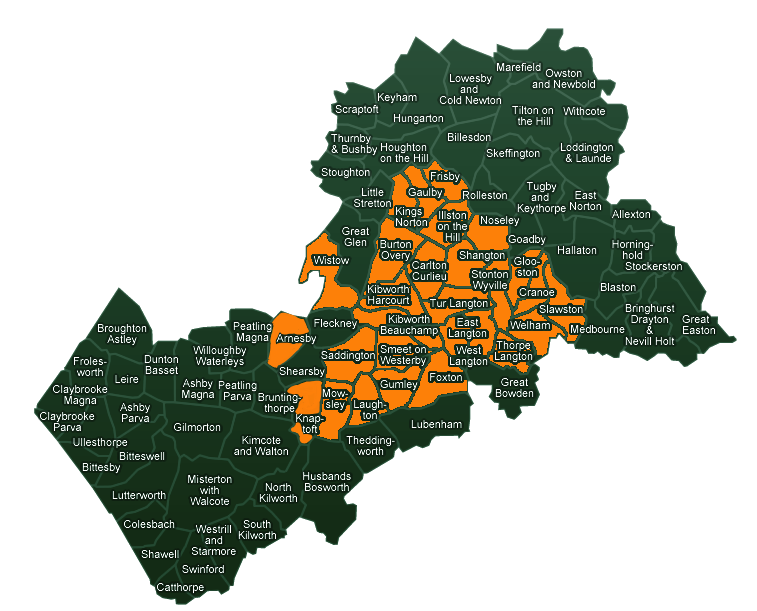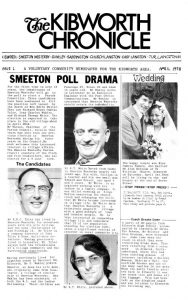The Story behind the First Issue
The Kibworth & District Chronicle started life in 1978, and has always been a Community Newspaper. All of the Chronicle’s staff are volunteers and give up their free time to manage, lay-up, administer and distribute over 5,000 free copies to many villages across South Leicestershire.
Distribution

The Chronicle is funded by revenue generated by advertisers and is a not-for-profit operation.
How to obtain a copy of The Chronicle
Copies of the Chronicle can be sent to those who subscribe – currently £10 per annum (from May 2017) for people in the UK. If you wish to take out a subscription please contact theeditor@kibworthchronicle.com by email letting us know your name and address. We will then let you know where to send your cheque etc.
A copy of the Chronicle is often available in the libraries of Kibworth and Great Glen. We ask for a donation for any copies obtained from the libraries and the money raised is sent to a charity for the sight impaired.
Talking Chronicle
Each month an audio recording on CD is made of many of the articles that appear in your Kibworth Chronicle. The Talking Chronicle recordings are delivered to those people who may have difficulty in reading the Chronicle in its printed format. We are very grateful to Mr & Mrs Greening for their continued help in recording these discs. If you know of someone who would benefit from receiving an audio version of the Chronicle please let us know by emailing theeditor@kibworthchronicle.com or via the Chronicle box in Kibworth Post Office.
The story behind the first issue
In the late 1970s Leicestershire Rural Community Council was interested in the possibilities of local community newspapers, two or three of which were already being produced in Leicestershire villages. An honorarium was paid to a man who had for several years been involved with the Blaby Courier. He was Daryl Taylor-Smith and he approached parish councils in villages he thought suitable for the launch of a community newspaper. Villages selected had to be of a certain size of population with enough potential circulation to attract advertising from nearby traders. He was granted permission to mount an exhibition in the Kibworth Library showing copies of the existing papers and inviting anyone interested to contact him.
Among those who were interested were Carol and Peter Baker, Geoff Crowther and Tony Hallows. With Daryl Taylor-Smith they contacted potential advertisers and tried to arrange a meeting with the joint parish councils, but Daryl felt the long wait for the meeting could delay the launch of a paper. A start in spring or early summer could help to build up a good advertising standard and some financial resources before the quieter trading period following Christmas. It was therefore decided to call a public meeting and notices were pushed through the letter boxes of all Kibworth residents.
In a somewhat acrimonious meeting attended by around fifty people, there was much discussion of the possible financing of a paper and many other aspects of publication. The Kibworth Parish Church was concerned about the possible loss of advertising in its magazine and the general opinion of parish councillors attending was that Kibworth had no need of such a paper and it certainly could not be self-financing–impossible! Daryl, who led the meeting, suggested that those present vote with their feet; those against the idea should leave and anyone interested should stay to explore further. This left about ten people, the majority of whom had not previously met each other, but they were all interested in the opportunity to seek out and write up news
Introductions were made with those present outlining their occupations and special interests. There was a secretary, a sales representative and an office manager amongst them– the nucleus of a team to produce and administer a community newspaper. Further meetings of this group followed and sufficient advertising was sold to cover the cost of producing a first edition. Then, as the first editor, Daryl, recalled,
“The problems really began with the need to produce adverts which looked good enough to help sell ‘our customers’ products. We all spent hours learning to use Letraset (those rub-down letters) without which we could not produce either headlines or advertising blocks. Much discussion was involved in the eventual decision not to place adverts on the front page (shades of The Times). Meanwhile, some of the group were interviewing newsworthy people but it was somewhat difficult in those days to introduce oneself as so-and-so from the Kibworth Chronicle
’ What’s that?’ would come the reply.
A week to go and we still had no obvious front page story and then we discovered that Smeeton Westerby was to have its first election for parish councillors for many years. The contestants were interviewed, photographed and there we were with a front page story.
The opinion was that we should have (if not a Page 3 Girl) at least a picture of an attractive young lady in the paper. Not a unanimous decision but arrangements were made between our photographer, a young lady and the owners of studio in Market Harborough. Late objections by the young lady’s nearest and dearest resulted in a high speed chase along the A6, some harsh words and inevitably no photograph being published. ‘Poetic justice’ was a phrase used by opponents of the original suggestion. And so to the day arranged to put it all together, to discover that much of the advertising still needed to be laid out and a lot of the material needed to be typed and retyped to accommodate the space available! I insisted that there should be no white space left and no glue must show on the front of adverts or news items. Eventually, he pronounced himself satisfied with the results, much to the relief of those involved. It had been a long hard day”.
A moment of panic followed on Monday when their proud efforts were delivered to the printer who had not realised the size of their publication sheets and could not cope with them. A hasty phone call revealed the name and address of the Blaby Courier’s printer and he was able to take on the work at short notice. Reactions of those involved with the first issue covered all human emotions from panic as lay-up day approached to joy when the finished paper was delivered from the printer.
‘From small acorns large oaks grow.’ The Kibworth Chronicle has now spread to over twenty five village and distributors deliver five thousand copies.


